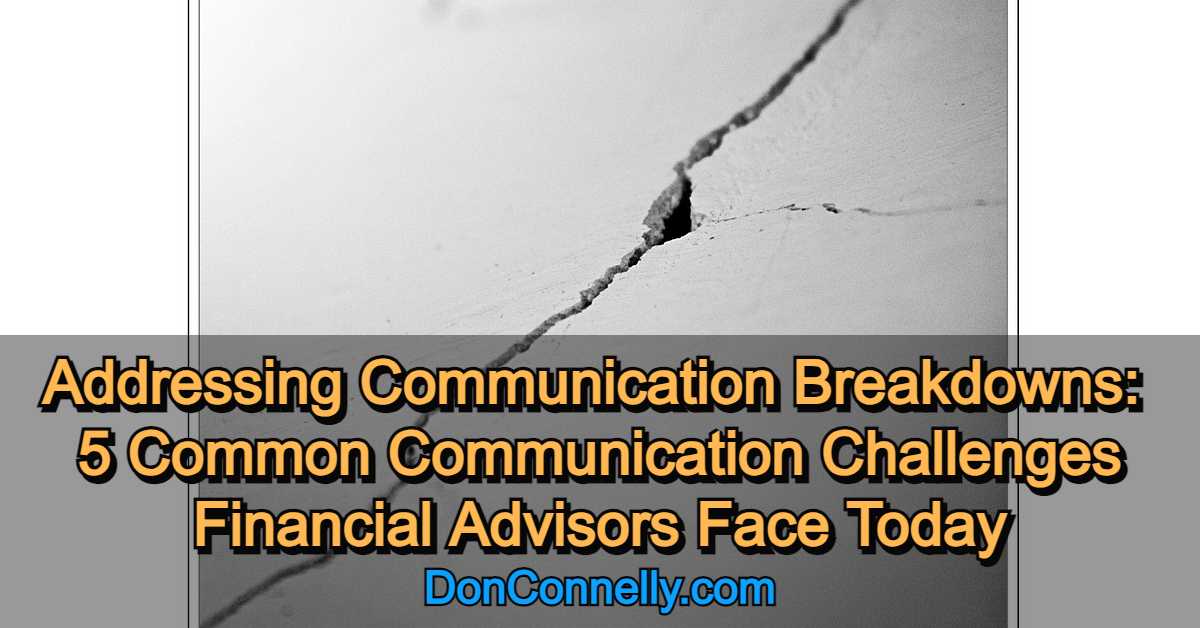Addressing Communication Breakdowns: 5 Common Communication Challenges Financial Advisors Face Today
 We spend a lot of time and space here harping on the importance of client communications because, more than anything else you do in this business, it can make or break you.
We spend a lot of time and space here harping on the importance of client communications because, more than anything else you do in this business, it can make or break you.
We’ve discussed that 72% of clients who fire their financial advisors do so due to poor communication. We’ve pointed out studies that show clients value solid communications the most in an advisory relationship, yet many feel they’re not receiving it.
We’ve also outlined the reasons why it’s critical to build a systematic communications structure designed to keep your clients engaged, cultivate loyalty, and instill confidence in your advice and then provided a framework for building it.
Above all, we’ve stressed the importance of continuously working on your communication and requisite soft skills for building trust and solidifying your relationship.
However, all that will do you little good if you don’t recognize the communication challenges you face on a daily basis, especially the communication breakdowns that lead to conflicts, such as miscommunications, misunderstandings, and a lack of clarity.
Here are five of the most common communication challenges financial advisors must recognize and overcome to build and maintain solid client relationships:
#1. Your clients have different levels of financial literacy
Your clients’ understanding of complex concepts varies across a broad spectrum. The amount of critical information you expect your clients to absorb can be overwhelming for most—though they may not let on. Until they are comfortable with key concepts such as risk and return, diversification, asset allocation, taxation, and inflation, they may not have confidence in you or your advice.
That’s why it’s crucial to learn how to chuck the technical jargon and explain complex concepts in an easy-to-understand manner. More importantly, you must adapt your communication style and tailor your advice to match your client’s knowledge level, ensuring they grasp all the concepts.
#2. Failure to engage clients on an emotional level
Financial advisors are trained to be rational and analytical thinkers. Yet, when it comes to their money, clients are emotionally driven, often by deep-seated fears, anxieties, or biases. It’s the primary reason clients will resist any change. Advisors who fail to connect with their clients on that level will never fully have their trust and be unable to instill confidence in their advice.
To reassure their clients, advisors must be able to relate to them on an emotional level, actively listening to their concerns, demonstrating genuine empathy, and addressing those concerns directly.
#3. Overcoming information overload
The financial world is vast, exceeded only by the amount of information available on it 24/7 through cable and the internet. For some clients, trying to consume all of it is as overwhelming as drinking from a firehose. For many, information overload can be paralyzing, making it difficult to discern between what is important and relevant and which is hyperbolic and destructive.
Advisors must filter and distill information to provide clients with relevant and actionable insights, presenting it in a concise and organized manner to help clients grasp critical points and make informed decisions.
#4. Deciphering multigenerational differences
The aging baby boom generation is making way for new generations seeking financial advice. Advisors hoping to grow their practices must be able to work with clients from different generations, each with unique financial attitudes, values, and goals.
Working successfully with clients from Gens X, Y, and Z is like learning three different languages or cultures. Bridging the generational divides requires a deep understanding of their perspectives, expectations, and preferences if you want to compete for their business.
#5. Clients have different communication preferences and expectations
According to a survey by YCharts, clients definitely factor in the frequency, style, and types of communications in deciding whether to stay with their advisor. That includes when and how they want to be contacted during good times and bad. Failure to accommodate their preferences and expectations to the letter can drive them into the arms of your competitors.
To address all these challenges, we recommend that advisors build a systematic communication strategy that accounts for the needs and preferences of all their clients and invest in ongoing professional development to enhance their communication skills. With the future of your advisory practice at stake, it would be essential to recognize and overcome all your communication challenges.
Watch this 3-minute video to learn how our 24-step program will help you improve your communication with clients, among other things.
See program details and enroll today!
Available as a self-paced video training program (always open!) or as a 12-week coaching program (open only a couple of times a year), this program will change the way you view your practice and will give you an enormous advantage over your competition. Select your format and enroll today!



